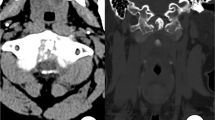Abstract
Purpose.
The purpose of this study was to verify the value of computed tomography (CT) in the diagnosis of the "crowned dens" syndrome, not only in crystal deposition diseases, but also in other rheumatic or nonrheumatic conditions.
Materials and methods.
Thirty-eight patients (15 men and 23 women; mean age 55 years; age range 35–79) with neck pain were examined and divided into two groups: (1) patients already identified as rheumatic and referred for further investigation of the atlantoaxial region; (2) patients with symptoms confined to the cervical spine, with inconclusive radiographic findings. Unenhanced CT of the cervical spine (Tomoscan SR 7000 Philips, Eindhoven, Netherlands) was performed in all patients. There were 11 cases of rheumatoid arthritis (ten women and one man), two calcium pyrophosphate dihydrate crystal deposition disease (both women), one of systemic sclerosis (a woman), one of osteoarthritis (a man), one of seronegative arthritis (a man), four of neoplasm (one woman and three men) with suspected cervical involvement, one (a man) of haematological disease (lymphoma), one (a woman) of menopausal osteoporosis, ten (five men and five women) of recent or previous trauma with suspected involvement of the skull base and first cervical vertebrae and six of unknown painful cervical dysfunction (three men and three women).
Results.
CT demonstrated calcific deposits around the dens in 12 patients (three men and nine women), in the transverse and alar ligaments, and in the anterior atlantooccipital membrane. CT revealed horseshoe- or crown-like calcification surrounding the odontoid process. In our series, other rheumatic diseases, especially rheumatoid arthritis, showed similar irregular calcifications of the atlantoaxial joint. Discussion. In calcium pyrophosphate dihydrate (CPPD) crystal deposition disease, the spine may be the only site of involvement, generally asymptomatic. Crystals located in the transverse ligament of the atlas give rise to the crowned dens syndrome, usually in patients affected by severe degenerative lesions of the atlantoaxial joint and peripheral chondrocalcinosis. Symptoms may be absent, or a neurological compressive syndrome may develop. Symptoms tend to worsen with age. The diagnosis is not always easy, as the symptoms are similar to those of other diseases, such as meningitis, cervicobrachial pain, occipitotemporal headache, calcific tendinitis of the longus colli muscle, spondylodiscitis and retropharyngeal abscess.
Conclusion.
CT is the gold standard in identifying crowned dens syndrome, as it is able to depict the shape and site of calcification and any bone erosions. Radiography of other joints (wrist, knee, pubic symphysis) may help to ascertain whether the disease is due to calcium pyrophosphate dihydrate or hydroxyapatite crystals, and is therefore recommended for routine patient management. Magnetic resonance imaging (MRI) is indicated for the study of neurological complications.
Similar content being viewed by others
Author information
Authors and Affiliations
Corresponding author
Additional information
*Il lavoro spetta in parti uguali agli autori
Rights and permissions
About this article
Cite this article
Scutellari, P.N., Galeotti, R., Leprotti, S. et al. The crowned dens syndrome. Evaluation with CT imaging. Radiol med 112, 195–207 (2007). https://doi.org/10.1007/s11547-007-0135-7
Received:
Accepted:
Published:
Issue Date:
DOI: https://doi.org/10.1007/s11547-007-0135-7




